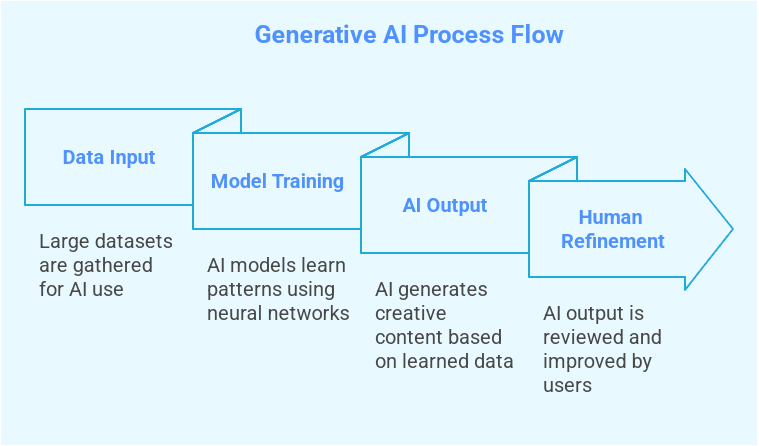

Generative AI is a subset of artificial intelligence that focuses on creating new content, whether it’s text, images, audio, or even code. Unlike traditional AI, which follows pre-programmed rules, generative AI leverages deep learning models, such as Generative Adversarial Networks (GANs) and transformers, to generate human-like content.
One of the most well-known examples of generative AI is OpenAI’s ChatGPT, which can generate text responses based on user input.
But how does generative AI work? It is learned on massive datasets and picks up patterns to produce outputs that replicate human-generated content. It has numerous applications in industries, so it is one of the most revolutionary technologies at present.
The applications of AI, more so generative AI, are numerous and growing. Some of the most prominent areas where generative AI is having a tremendous impact include:
Content generation is one of the most notable applications of generative AI. It can be used to generate:
Generative AI can produce beautiful images and videos from basic prompts. Some of the most popular applications are:
In the healthcare sector, generative AI is transforming medical research and patient treatment.
Learning is another field where generative AI is redefining learning.
Generative AI is used by developers for:
Generative AI helps make financial and business decision-making more effective.
AI is utilized in gaming to generate dynamic experiences.
Generative AI is used significantly to improve customer experience in retail.
| Feature | Traditional AI | Generative AI |
|---|---|---|
| Definition | Analyzes data, follows rules, and makes decisions | Creates new content based on learned patterns |
| Core Function | Classification, prediction, automation | Content generation, design, and creativity |
| Data Use | Uses structured data for analysis | Uses large datasets to generate new outputs |
| Examples | Spam filters, recommendation systems, fraud detection | AI chatbots, image & text generation, AI music composition |
| Flexibility | Performs pre-defined tasks | Adapts and creates new content |
| Human Role | Mostly oversight and maintenance | Collaboration and refinement of AI-generated content |
Businesses require a systematic approach to apply generative AI. The following are some key steps:
Before incorporating AI, identify the issues you seek to address. Whether it’s customer service automation, marketing material generation, or medical diagnostic imaging, knowing exactly what you seek to achieve streamlines the proper AI model choice.
A variety of models exists for diverse uses:
AI models need big data for training. Provide high-quality, unbiased data to obtain higher accuracy and fairness.
Integrate AI with current systems through APIs or cloud platforms. Test thoroughly before deployment.
AI models need to be monitored and updated regularly to enhance performance and guarantee ethical use.

The future of generative AI is bright, with improvements in:
Generative AI is transforming industries and changing the way companies do business. If you’re in healthcare, education, finance, or entertainment, incorporating generative AI can improve efficiency and innovation. However ethical implications need to be considered to ensure proper use.
As AI technology advances, being aware and adjusting to new developments will be essential to unlocking its full potential. Are you ready to unlock the potential of generative AI?